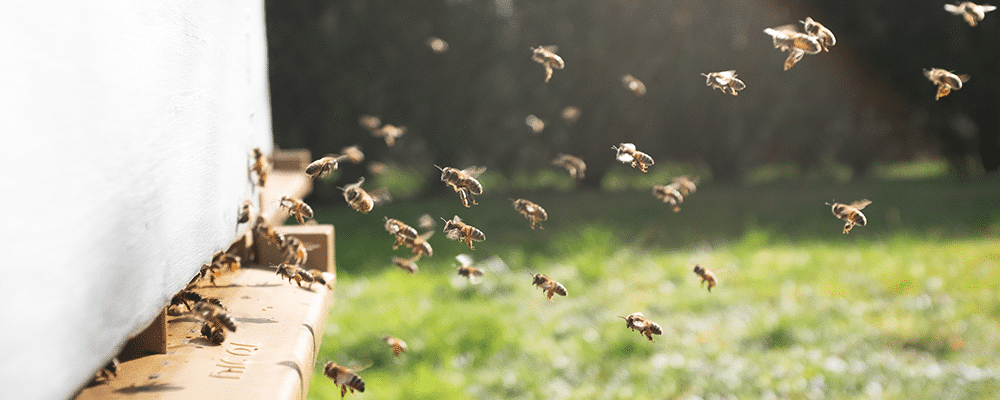
Inclusive development, to INCLUDE, is development that aims to reduce poverty and inequality through ensuring participation of marginalised/excluded groups of people in the development process, in terms of both non-income and income dimensions of poverty (1). Productive employment is identified as one of the domains in which poverty and inequality can be reduced. The linkage here is increased access to decent jobs in a formalised and non-formalised labour markets especially in developing countries like Uganda is key to improving living conditions and it is a critical element in achieving sustainable development
Various renditions of the concept inclusive development have become part of development policy making and programming. Whereas inclusion is taking over the discourse of development, the exact meaning and operationalisation of this concept are not entirely clear. For development organisations this concept can play out in various ways. Rather than focusing on the word of inclusion, this blog focuses on the work of inclusion. The aim of this blog is to show a concrete example of inclusion in practice, embodied by the Inclusion officer at The Uganda National Apiculture Development Organisation (TUNADO), a member-based national apex organisation for apiculture in Uganda. Beekeeping, they argue, should be an accessible option for everyone because anyone can do beekeeping. A permanently staffed Inclusion Officer is in place to ensure that this focus is observed. This blog asks the questions what is inclusion in the apiculture sector on top of other aspects of value chain development? How does the inclusion officer work, and how does TUNADO facilitate the inclusion officer and inclusion in practice?
Challenges for beekeepers
Before understanding vulnerabilities and barriers to inclusion for various social groups, the general challenges of the beekeeping sector should be understood. Common challenges in the apiculture value chain exist for all its actors. For more on the apiculture value chain in general, read this blog. The challenges stem from structural aspects of the value chain, such as its fragmentation, and the links to markets that are often not optimal. These challenges apply – although unequally – to most beekeepers starting their apiaries in Uganda, and to most of them who have managed to expand beyond critical mass of 15 beehives (with 10 colonies). Besides these structural challenges, beekeeping itself for smallholders or beginning beekeepers can become difficult when faced with practical problems. For example, due to the responsibility the beekeeper has for their bees, which are considered lethal livestock in Uganda, a fence is necessary to avoid accidents with cattle or neighbours which can result in injuries and sometimes casualties on one side, and heavy legal repercussions on the other. The fence may also prevent neighbours from stealing honey. If one has a plot of land and a few hives at their disposal, getting bees into them requires technical know-how and experience. A beehive without bees is as good as not having one. The next step is apiary management and ultimately harvesting. To safely monitor and harvest the colonised beehives, one needs equipment such as a bee suit with gloves and gumboots, a bee brush, harvesting knife, hive tool, smoker and airtight buckets.
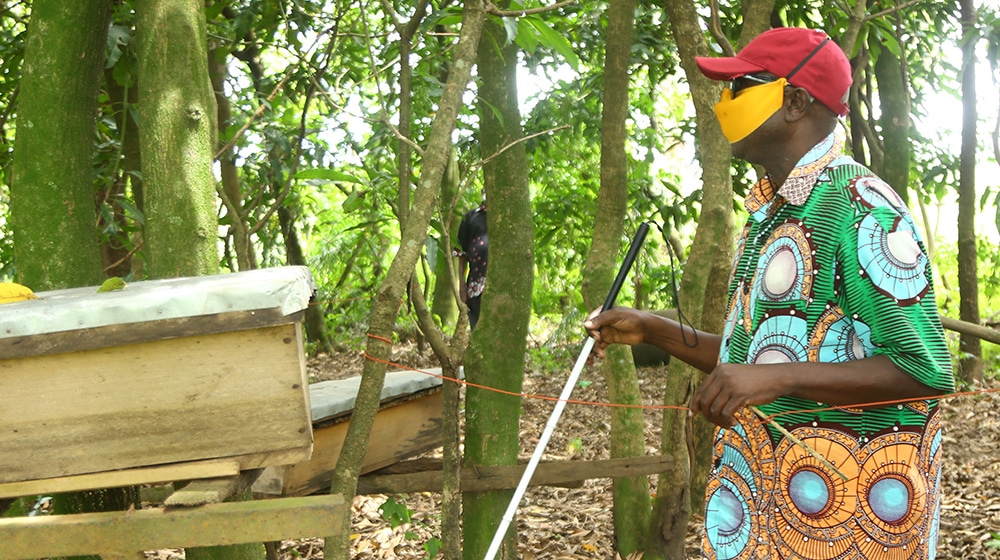
Beekeeper with visual impairment using string to navigate his apiary / Image credit: Stephen Muwanguzi TUNADO
Beekeeping can be profitable from 15 colonised hives onwards. Including the equipment, the beekeeper would have to invest an estimated (15 traditional beehives*30,000 + bee suit 150,000 + smoker 50,000 + boots 25,000 + gloves 30,000 + bucket 25,000 =) 430,000 Ugandan Shillings based on World of Bees prices (which is about 122 U$D in January 2022). To maintain and protect the apiary, a fence should also be factored in. The beehives can be made locally, which can cause the price to go down, or they can be produced by beekeepers themselves. Some of the equipment is available through the Rural Transformation Centres (one-stop-shops for beekeeping training, equipment and inputs connected to TUNADO) for communal use. This means that some of the initial investments could go down or could be postponed.
As most informal smallholder rural agricultural entrepreneurs, beekeepers face a structural challenge to gain access to finance, in the form of credit or loans from formal sources. The Microfinance institutions are not geared towards the apiculture sector. On top of that, beekeepers are not able to show records and present collateral to meet the KYC requirements. This means that even though investments may be small at first, a starting beekeeper may struggle to meet them without external credit.
Inclusion analysis in the apiculture sector
In organising a historically fragmented sector with little organisation and mostly smallholders, TUNADO identifies 6 social categories facing extra challenges towards participation in apiculture. People falling in one or more of these categories face sometimes overlapping challenges to partake in activities along the apiculture value chain, be it in beekeeping (primary production), processing and packaging, marketing, or trading. First, youth are finding access to the required assets and capital (land, credit) hard. Often youth do not own or access land and do not have the resources or independence to start up beekeeping. Secondly, women face these challenges more disproportionally, adding other social and traditional expectations of care work, marriage, and mobility to their situations. According to a survey conducted by Woord en Daad PMEL Expert in Uganda in December 2021 under Human Centred Design technical support by Palladium, female youth find it harder to get land compared to their male counterparts due to patriarchal nature of Ugandan society. Thirdly, persons with disabilities face similar constraints, e.g., physical obstacles to persons with vision impairment (PwVI) and persons with hearing impairment (PWHI), who need extra adaptations in their communication and apiary work sites.
Fourthly, there are ethnic minorities that face peculiar vulnerabilities due to historical processes of marginalisation, such as the Batwa people in the west, and the Ik people in Karamoja close to Kenya. The Batwa, historically forest dwellers, have been evicted from their ancestral grounds and find hardships in securing alternative livelihoods. The Ik, who are situated between cattle keepers of Turkana and the Karamojong close to the Kenyan border, face cattle raids from both sides and are being pushed out. Refugees, of which there are many in Uganda, form the fifth vulnerable group. The refugees are located mostly in refugee settlements near the Sudanese and Congolese borders and face multiple barriers to engage in beekeeping, e.g., they are congested in the settlements and have small plots (3 x 3m) which makes primary production difficult, lack skills and there exists mistrust between them and host communities, which makes integration into host community apiary groups difficult.
Uganda employs a national poverty index that identifies regions with higher levels of poverty to guide policy and programs of poverty alleviation. This method of poverty targeting may overlook people living in poverty in regions that are not considered to be the poorest. TUNADO calls these groups that miss the boat the active poor; these face constraints in levels of education, skills, and access to land, finance, and assets, and require a tailored and intensive supportive approach to set up a business in beekeeping. This is the sixth and final category TUNADO uses for its focus on inclusion. These categories are not mutually exclusive, as one person may fall in one or several of these categories and face some or all challenges above depending on their personal context and environment.
The inclusion officer
The above mentioned social categories add their own challenges on top of the more general access to finance, land, and knowledge barriers for rural smallholders to successful beekeeping. This also shows that inclusion is highly context sensitive and depends on an interplay of factors. The inclusion officer, and TUNADO in a broader way, addresses these vulnerabilities and challenges. This function originated from a pilot project to improve the inclusion of persons with disabilities in beekeeping: a project officer with a background in sign language interpretation was recruited to facilitate the process with persons with hearing impairment and persons with vision impairment that are keeping bees in Gulu and Jinja. TUNADO realised that a focus on inclusion should transcend project level and be applied programme wide to increase participation of excluded and marginalised categories of people. After this project was successful, it was considered as a pilot for a more programmatic approach to inclusion. The project officer was incorporated in the permanent staff and involved in other projects as inclusion officer. She has been involved in a scoping study on inclusion for the five-year strategic plan of 2022-2027 and among other things worked to improve accessibility of the construction of a new building that will host TUNADO office, an export hub, a demo apiary, and a beekeeping museum. The inclusion officer is mandated by the organisation to address issues of inclusion and propose changes. One of the roles is to ensure that inclusion policy is being implemented according to an implementation framework, while addressing issues of inclusion in interventions to come.
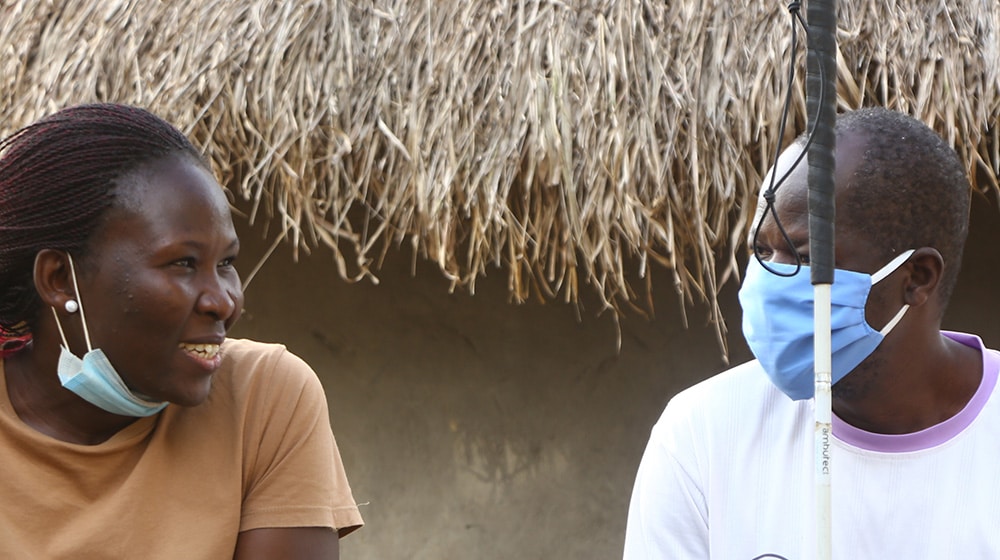
Inclusion Officer Hope Agwang working with person with visual impairment / Image credit: Stephen Muwanguzi TUNADO
The effectiveness of the work of this inclusion officer depends on several factors. First, the experience, background and seniority of the person fulfilling the function matters greatly for its effectiveness. Secondly, the policies and implementation roadmaps and timelines in place within the organisation provide the inclusion officer with the necessary tools. These policies and implementation guidelines should be concrete, workable, specific, and realistic. Lastly, the embeddedness of the position within the organisation and the commitment to inclusion as a core value play a role. Arguably, an organisation that does not consider inclusion as a core value is less likely to employ an inclusion officer.
Inclusion as a strategic core value
On a strategic level, TUNADO has committed to inclusion in several ways. A gender policy guides on the budget commitments towards gender inclusion (30% of the annual budget), same with disability policy (2%). All projects and programmes have mainstreamed the Gender Action Learning System methodology, which is a gender empowerment methodology that is based on dialogues in communities and households that are used as a negotiation tool for women inclusion. Staff and board have been trained in disability and gender inclusion within the projects and in the organisation. A gender analysis for the honey value chain was conducted to guide programming and it will continue to be updated. Programmes and projects are directed to spend effort to bridge the gap for persons with specific challenges due to intersecting (2) characteristics. In practice this means monitoring the quantitative and qualitative indicators of inclusion, such as proportion of women in beekeeping, differences in production, access to equipment, capital, and assets, and so forth.
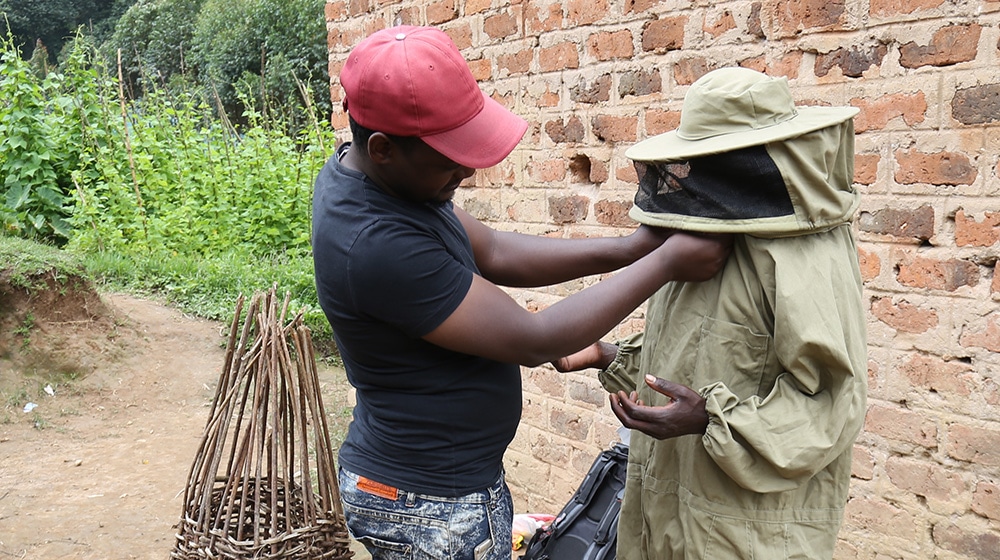
Beekeeper trying on a bee suit during a training / Image credit: Stephen Muwanguzi TUNADO
Whereas gender parity is a common first approach on the inclusion front, a wider focus on intersections of multiple characteristics that pose particular challenges is necessary. The mechanisms behind inclusion and exclusion play a central role in inclusion policy as input for analyses and policies. However, without the organisational and strategic backing of principles of inclusion, it is very difficult to put it into concrete practices. It is necessary to weave inclusion into the organisational structure with internal policies, embedded in concrete implementation guides that set clear and realistic goals, combined with staff training and monitoring.
Acknowledgements
This blog is a cooperation between INCLUDE, Woord en Daad, TRIAS and TUNADO. The three organisations implement Trees x Bees in Uganda, as a consortium under the Challenge Fund for Youth Employment. This project seeks to connect coffee farming, beekeeping and tree planting for pollination, honey production, reforestation, and climate resilient agroforestry.
(1) Reinders, S., Dekker, M., van Kesteren, F., Oudenhuijsen, L., 2019. Inclusive Development in Africa (Synthesis report), Synthesis Report series. INCLUDE Knowledge Platform, Leiden, the Netherlands. https://includeplatform.net/publications/synthesis-report-inclusive-development-in-africa/
(2) Intersectionality refers to each one’s unique experience due to anything that affects marginalisation in their lifetimes, which can be gender, family composition, assets, and other individual and social characteristics. First coined by Prof. Kimberlé Crenshaw in 1989 (Crenshaw, 1991).

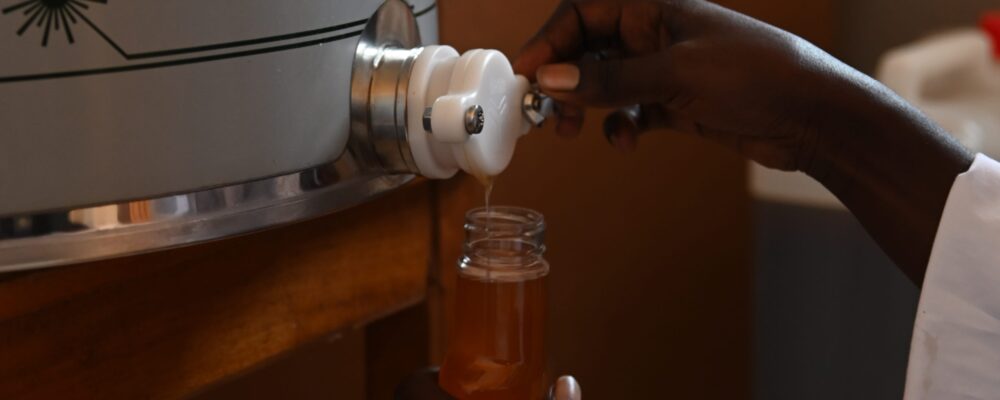

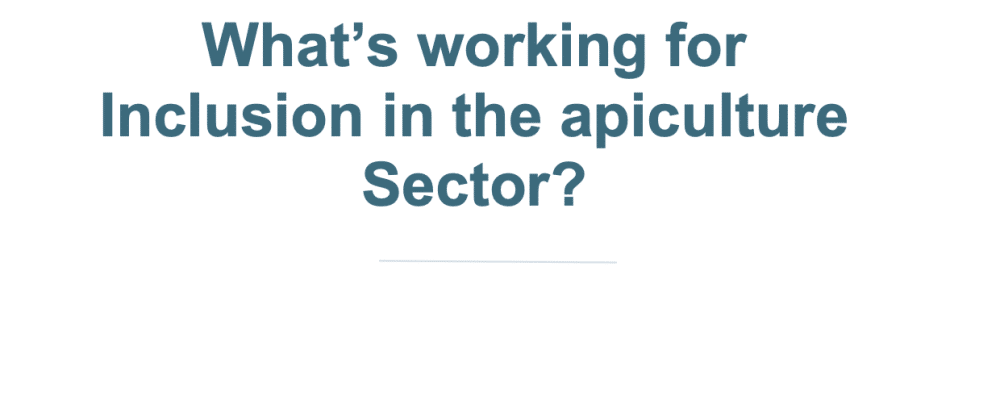
The intervention of TUNADO to mobilise, strengthen farmer groups is key. The involvement of vulnerable groups like neglected communities like the batwa, in Kisoro, Disabled persons but could be resourceful in some areas along the apiculture value chain.
Mobilisation of communities along protected areas would be a great opportunity to tap the natural benefits from those areas.
Value addition from the farm, is key in honey, bees wax and propolis production. Our beekeepers are still facing challenges in accessing value addition equipment. There is need to receive a strong advocacy for tax waiver on a number of value addition equipment.
Capacity building of our youths in small equipment management, items like honey presses that would be hired out during honey harvesting,